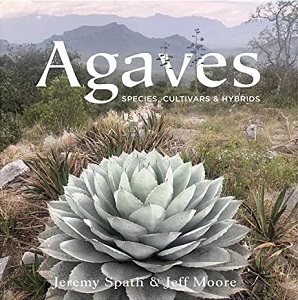
When I visit desert gardens in conservatories, or in captivating places such as the
Desert Botanical Garden in Phoenix, I’m always drawn to the agaves. My favorite is
Agave victoriae-reginae, a native of the Chihuahua Desert of Mexico that enchanted me the first time I visited my parents when they lived in Arizona. The precise white lines on the leaves look as though they were applied with a fine paintbrush.
On subsequent visits, I learned there are many other agaves with fascinating foliage patterns, forms, and textures. I also glimpsed the infrequent towering inflorescences; one final performance before the central plant dies, although often with offsets ready to carry on.
Agaves: Species, Cultivars & Hybrids is a new book in the Miller Library by Southern California authors Jeremy Spath and Jeff Moore. There are other books that discuss the botanical aspects of the genus, or uses by humans (tequila, anyone?) and animals. This instead is a horticultural review of the many forms emphasizing their aesthetic and cultural traits, beautifully illustrated in both nature and cultivation. Before you dismiss the possibility of growing these in Seattle, because it’s too cold, and especially too wet in the winter – think again.
Although primarily native to Mexico, several species are from high altitudes and with proper siting and protection from being waterlogged can make spectacular garden or container subjects in our area. An example is the story of Monte, an
Agave montana plant growing in Portland, as told in an essay and photographed in the book by its owner, Lance Wright.
This species is from the eastern Sierra Madre Mountains in southern Chihuahua, where it receives significant rainfall, which may explain its ability to survive for 18 years in the ground in the Pacific Northwest. Like all in its genus, Monte gave one final farewell performance by blooming, but what a performance!
The first emergence of a bloom stalk was in late September, eventually reaching a flowering height of 15 feet the following spring. “The City came out on May 9 to do traffic control as crowds were standing in the street slowing traffic to take pictures.” If you want a media star in your garden, this is your plant!